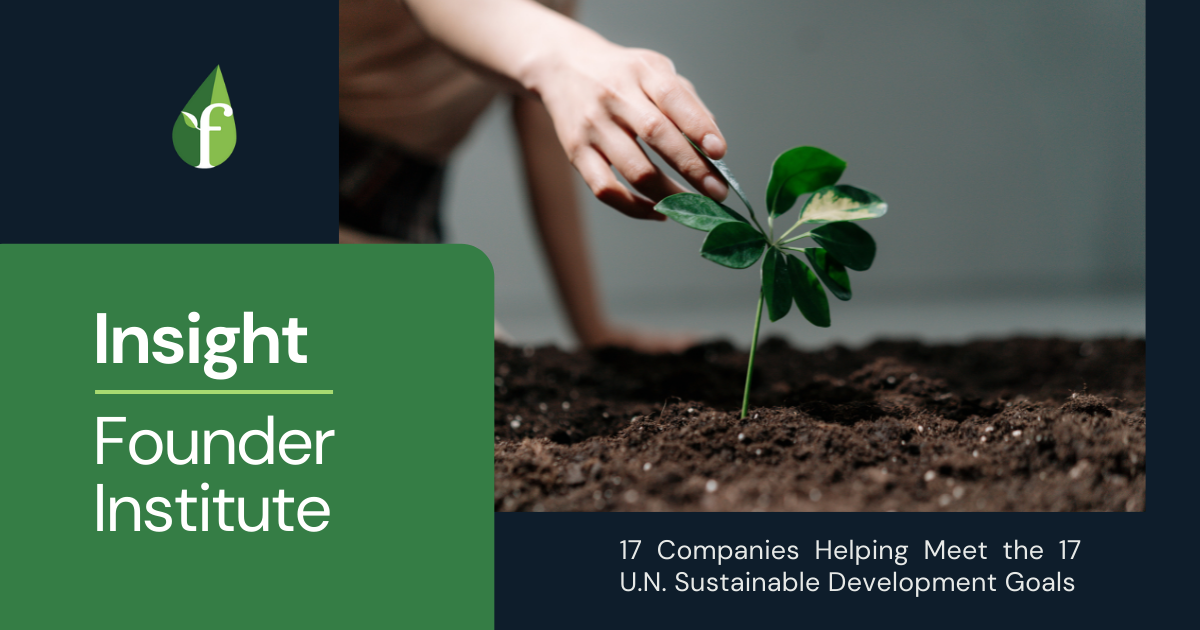
Food technology and agricultural industries are changing rapidly, becoming necessarily more sustainable and more productive, to feed a growing world.
One question we hear constantly from early-stage social entrepreneurs is,
How can I measure my impact, or gather data to quantify the net-good being created by my social impact company?
To help social entrepreneurs in the food and ag-tech space to answer this critical question, the Founder Institute has created a list of impact metrics, specifically for consistently measuring and reporting on the impact created from agriculture or food-tech innovations.
These metrics are adapted directly from the sub-sections of the United Nations’ 17 Sustainable Development Goals, and demonstrate clear benchmarks recognized by leading global authorities as key performance indicators for success in these critical areas.
You can learn more about our FI for Good initiative here, and more about Founder Institute’s invitation to entrepreneurs and startup organizations worldwide to adopt the UN’s 17 SDGs as a framework for measuring impact, as well as sign the joint Pledge for Responsible Innovation here.
Sustainable Development Goal 2: Zero Hunger
By 2030, end hunger and ensure access by all people—in particular, the poor and people in vulnerable situations, including infants—to safe, nutritious, and sufficient food all year round.
- Increased efficiency of logistical supply chains in agriculture, which ensures access to markets and affordable food. (Measure of technology-beneficiaries’ logistical efficiency versus overall local rate)
- Number of people no longer classified as undernourished according to local/regional/national classifications, measured as a proportion of population, versus non-beneficiary equivalent/sample population rate(s).
- Number of people removed from moderate or severe food insecurity, measured as a proportion of population against local/regional/national classification rate(s).
By 2030, end all forms of malnutrition, including achieving, by 2025, the internationally agreed targets on stunting and wasting in children under 5 years of age, and address the nutritional needs of adolescent girls, pregnant and lactating women, and older persons.
- Number of children under 5 years per 100,000 no longer classified as stunted (height for age value greater than -2 standard deviations from the median World Health Organization Child Growth Standards).
- Number of children under 5 years per 100,000 no longer classified as malnourished (a height for weight value greater than -2 standard deviations from the median World Health Organization Child Growth Standards).
By 2030, double the agricultural productivity and incomes of small-scale food producers, in particular women, indigenous peoples, family farmers, pastoralists and fishers, including through secure and equal access to land, other productive resources and inputs, knowledge, financial services, markets, and opportunities for value addition and non-farm employment.
- Increase in production per labour unit in beneficiaries of technology for small-scale farming, pastoral, and forestry enterprises, versus sample population local/regional/national classification rate(s).
- Increase in the average income of women or indigenous peoples (technology beneficiaries) who are performing labour in small-scale food production, versus sample population local/regional/national classification rate(s).
By 2030, ensure sustainable food production systems and implement resilient agricultural practices that increase productivity and production, that help maintain ecosystems, that strengthen capacity for adaptation to climate change, extreme weather, drought, flooding and other disasters, and that progressively improve land and soil quality.
- Increased proportion of agricultural area using productive and sustainable agricultural practices, measured as a percentage of total local/sample agricultural area.
By 2030, maintain the genetic diversity of seeds, cultivated plants, and farmed and domesticated animals and their related wild species, including through soundly managed and diversified seed and plant banks at the national, regional and international levels, and promote access to and fair and equitable sharing of benefits arising from the utilization of genetic resources and associated traditional knowledge, as internationally agreed.
- Measure number of plant and animal genetic resources for food and agriculture added to either medium- or long-term conservation facilities, versus before implementation.
- Measure reduction in the number of locally-farmed breeds or cultivated phyla classified as at risk of extinction, according to local or national classification.
A Increase investment, including through enhanced international cooperation, in rural infrastructure, agricultural research and extension services, technology development and plant and livestock gene banks, in order to enhance agricultural productive capacity in developing countries, and in particular, the least developed countries.
- Measure increase in total official flows (official development assistance plus other official flows including foreign direct investment) to the agriculture sectors of developing countries.
Correct and prevent trade restrictions and distortions in world agricultural markets, including through the parallel elimination of all forms of agricultural export subsidies and all export measures with equivalent effect, in accordance with the mandate of the Doha Development Round.
- Measurement of total reduced value of agricultural export subsidies.
Adopt measures to ensure the proper functioning of food commodity markets, and their derivatives, and facilitate timely access to market information, including on food reserves, in order to help limit extreme food price volatility.
- Measured reduction (over time) in food price volatility indices, as a comparative before and after or timescale measured against new technological implementation.
Founder Institute portfolio companies are creating positive social and environmental impact around the world, using structured processes to define impact KPIs that scale sustainably with their business. Read the most recent featured reports on our impact companies at FI.co/good, or learn about the Founder Institute's own global impact at FI.co/impact.




